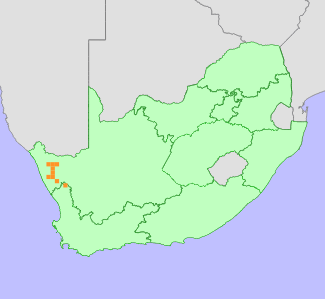|
Scientific Name | Conophytum depressum Lavis subsp. depressum |
Higher Classification | Dicotyledons |
Family | AIZOACEAE |
National Status |
Status and Criteria | Endangered A4d; B1b(v)c(iv)+2b(v)c(iv) |
Assessment Date | 2021/11/26 |
Assessor(s) | A.J. Young, P.G. Desmet, I. Ebrahim, D. Guo, A. Harrower, L. Jabar, L. Knoetze, C. Rodgerson, P.C.V. Van Wyk & N.N. Mhlongo |
Justification | This succulent is endemic to the Northern Cape province of South Africa with an extent of occurrence (EOO) of 3,159 km² and area of occupancy (AOO) of 64 km². The plants are comparatively short-lived at 5-10 years compared to other species in the genus and fieldwork suggests that population sizes may fluctuate considerably from one year to the next. The population is in decline due to the illegal ornamental succulent plant trade, with collection likely to increase as there has been a dramatic increase in the number of species and volume of plants targeted since 2019. This taxon can be very challenging in cultivation and the continued threat of illegal collection is therefore regarded as very high for this particular succulent. However, the cryptic nature of the plants and highly dispersed distribution across its range may limit future declines to 55% of the population within the next thirty years. It therefore qualifies as Endangered under criteria A4 and B1+2. |
Distribution |
Endemism | South African endemic |
Provincial distribution | Northern Cape |
Range | This succulent is endemic to the Northern Cape province of South Africa. |
Habitat and Ecology |
Major system | Terrestrial |
Major habitats | Succulent Karoo |
Description | Plants are scattered across a relatively wide area of winter rainfall region of the Northern Cape province. It is predominantly restricted to the Namaqualand Hardeveld bioregion of the Succulent Karoo biome. The plants occupy shallow grit and detritus-filled weathered pans on granite and gneiss. This taxon has a generation length of 10 years. It is expected to be sensitive to the impacts of climate change as it does not disperse and while adapted to arid conditions, is dependent on limited seasonal rainfall. Species in the genus are sensitive to long periods of drought. Drought related mortality has been observed for other closely related taxa within the genus. |
Threats |
| This succulent is currently threatened by illegal collection for the international trade in ornamental succulents with several thousand plants removed from habitat since 2019. This pressure is likely to increase in future as there has been a dramatic increase in the number of species and volume of plants targeted since 2019 and this particular succulent is very challenging in cultivation. Grazing and trampling by livestock is a localised threat to some populations.
Anthropogenic climate change is a long-term threat to this succulent. Climate models for the likely emission scenarios where emissions stay at present day levels (RCP 2.6) (Hausfather and Peters 2020) and worst case scenarios where emissions continue to increase during the 21st century (RCP 8.5) indicate that there will be a loss of suitable bioclimatic envelope of between 75% and 98% by 2080 for this succulent. Species in this genus have limited dispersal ability and migration to suitable habitats elsewhere is regarded as highly unlikely. However, this taxon occurs across several vegetation units and possesses certain morphological traits that are expected to provide a level of resilience to climate change. As a result the likely impact of climate change is expected to be reduced 20% to 55% based on the uncertainty of the response given the expected resilience of this taxon. Given the uncertainty of this species' response to climate change and the fact that it has a generation length of only 10 years, climate predictions are not used to inform the overall assessment. |
Population |
It is extremely small and highly cryptic making accurate estimates of population size extremely difficult. It has been recorded from at least 20 locations where numbers of mature individuals vary from just a handful to several hundred. The plants are probably not long lived in habitat and populations at each locality may vary greatly over a relatively short period. The total population is probably well in excess of 25,000 mature individuals. The population is in decline due to illegal collection to supply the international trade in ornamental succulents. At least 9,000 plants have been removed from habitat between 2019 and the end of 2021 based on confiscation records, with many more having likely been removed but not intercepted by law enforcers.
|
Population trend | Decreasing |
Assessment History |
Taxon assessed |
Status and Criteria |
Citation/Red List version | | Conophytum depressum Lavis subsp. depressum | Least Concern | Raimondo et al. (2009) | |
Bibliography |
Hammer, S. 2002. Dumpling and his wife: New view of the genus Conophytum. EAE Creative Colour, Norwich.
Hammer, S.A. 1993. The genus Conophytum: A conograph. Succulent Plant Publications, Pretoria.
Hausfather, Z. and Peters, G.P. 2020. Emissions - the 'business as usual' story is misleading. Nature 577(618-620).
Opel, M.R. 2004. The rediscovery of Crassula alcicornis. Haseltonia 10:38-40.
|
Citation |
| Young, A.J., Desmet, P.G., Ebrahim, I., Guo, D., Harrower, A., Jabar, L., Knoetze, L., Rodgerson, C., Van Wyk, P.C.V. & Mhlongo, N.N. 2021. Conophytum depressum Lavis subsp. depressum. National Assessment: Red List of South African Plants version 2024.1. Accessed on 2025/11/07 |
 Comment on this assessment
Comment on this assessment


